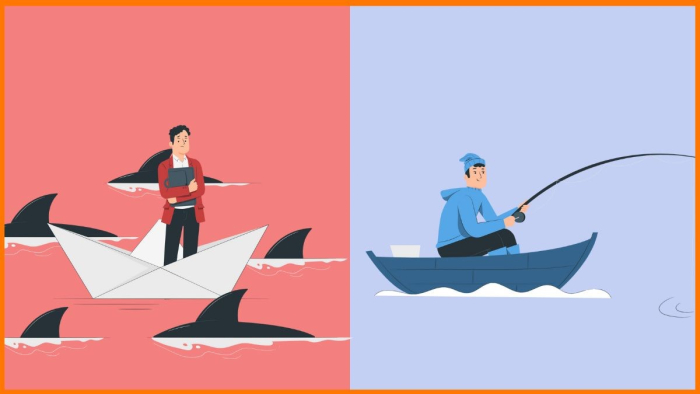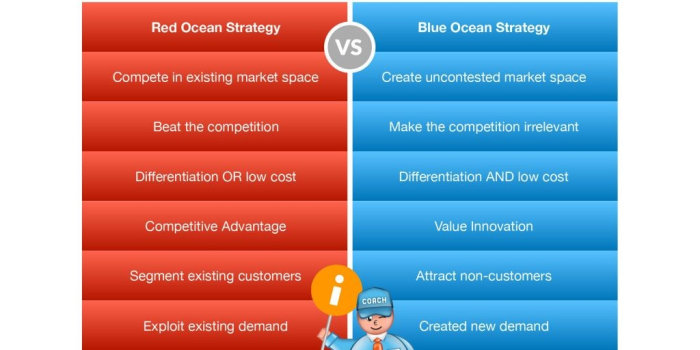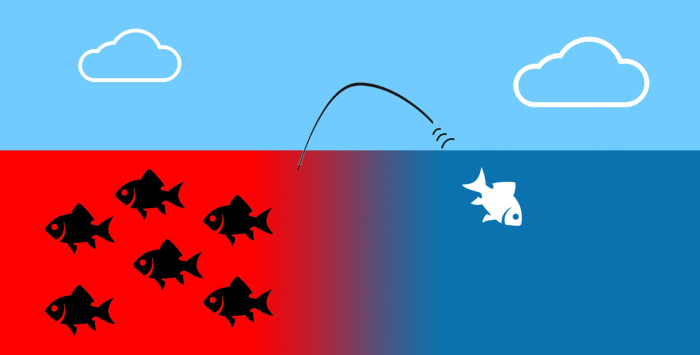
 Data Structure
Data Structure Networking
Networking RDBMS
RDBMS Operating System
Operating System Java
Java MS Excel
MS Excel iOS
iOS HTML
HTML CSS
CSS Android
Android Python
Python C Programming
C Programming C++
C++ C#
C# MongoDB
MongoDB MySQL
MySQL Javascript
Javascript PHP
PHP
- Selected Reading
- UPSC IAS Exams Notes
- Developer's Best Practices
- Questions and Answers
- Effective Resume Writing
- HR Interview Questions
- Computer Glossary
- Who is Who
Red Ocean and Blue Ocean Market Strategies
Red Ocean and Blue Ocean strategies help us understand the market space the launch of a new product will be facing. These strategies help the entrepreneur make the right decisions and implement strategies that will help the product survive and excel in the business environment.
Understanding the Red Ocean and the Blue Ocean Marketing Strategies

These terms were first coined by Renée Mauborgne and Chan Kim. Red Ocean's marketplace strategy applies to the products which are launched into an existing, well-defined, and developed market space. In this sense, in this market space, there are competitors and the firms are earning normal profits. For example, if a new biscuit is being launched into the market. We already have cream biscuits, cookies, and sour biscuits, available in different flavors and others. The red ocean, like the red color, defines the blood, passion, and love among competitors.
Blue Ocean's marketing strategy on the other hand is the new and unique market space. There are no competitors in the market and the firm can get a first-mover advantage and earn a super-normal profit. Blue ocean just like the blue color defines the calmness, depth, and possibility of opportunities a firm might face when they launch a new and unique product. It takes a long time to set the product right, gets consumers in favor of the product, and create a market space for the same. For example, when Alexander Graham Bell first discovered the telephone.

Detailed Comparison
Now we will be doing a comparative analysis of both market spaces for a better understanding.
| Red Ocean | Blue Ocean |
|---|---|
The firm will be operating in an existing market space. This market is a developed one. |
The entrepreneur or the product has to create a market of its own. They have to identify their customers and start everything from scratch. |
Entrepreneurs can learn from the mistakes of other firms. The setup of the product, machines, and workspaces are all known to the firms. They can easily duplicate successful firms. |
There is no past data available. Everything that they find has to be implemented and test run by the firm itself. |
The firms generally differentiate their products in terms of the cost of the product or by the improvisation of the existing products. For example, the iPhone launches new products by improvising on the existing set, sometimes in terms of camera or storage space. |
The firm has to launch a completely new product. This product has to solve an existing problem that the consumers might be facing. Sometimes this issue is known to the public even if they are not aware. For example, the advent of cameras to capture a particular moment. |
There is existing demand in the market. The first mover has tapped the market. New firms enter the fight for the limited market demand. Here the profits and opportunities are becoming increasingly limited. |
There is no existing demand in the market. For the manager, the market is borderless and untapped. This is profitable for the company in terms of infinite opportunities but also there is this dire need to create demand. If the customer cannot connect with the need for the product the firm might fail miserably. |
The major aim of this strategy is to beat the competition in the market. The competition can be run down by either the low cost of the product or the improvisations of the product. Sometimes both of these are introduced to capture the existing market and showcase extreme cannibalism |
The major aim of this marketing strategy is to make the competition irrelevant. This firm aims at succeeding by capturing an untapped market and fulfilling an unknown need. |
Red ocean aims at getting a competitive advantage over its competitors. It is like walking on eggshells. |
Blue ocean aims at creating value innovation. It helps the consumer in solving an unresolved need and providing value and innovations to the customers. The firms aim at both the low cost of the product and the value of innovation. |
|
Example of Blue Ocean strategy in today's market space: Uber ? The application understood the problem of high fares, denials in going to a certain location, and finding the cab at your doorstep. These issues lead to the creation of Uber. In the red sea of public transportation and local taxis, Uber created a blue ocean for cabs at your doorstep when you require them. Airbnb ? Not all homes are completely occupied. People who want to rent out their space as well as socialize with other beings find this application the perfect match. Airbnb helped renters in earning extra income from the unutilized space and travelers in getting home-cooked food, and cheap and safe locations for their stay. |
Example of Blue Ocean strategy in today's market space: Jio ? Understood the monopoly of the sim card providers. Disrupted the total market space with free internet connection and then made the internet connectivity stronger and more cost reliable. In the already existing red sea of sim card providers, Jio made sure that companies work according to their set price. Spicejet ? Understood the need of the consumer to have traveling options at low cost. Not every passenger is fond of the food and excellent services. For many, traveling is their only and most important priority. Spicejet provided customers with low-cost airfare in different city locations. It created price differentiation in an already existing red ocean. |

In today's world, however, every ocean seems to be a red ocean because there are direct or indirect competitors for all the products. For converting a red ocean into a blue ocean the firm can ask four strategic and logical questions to the existing market space.
How to Eliminate ? What are the tasks, technology, or manpower that can be eliminated while creating the product? It aims at achieving efficiency by eliminating redundant tasks.
How to Reduce ? What costs, processes, raw materials, and human resources could be reduced without hampering the product and its production?
How to Raise ? What are the parameters in the product that the company can raise to increase customer satisfaction? This helps in enhancing the value and importance of the product.
How to Create ? What are the other parameters or factors that can be created in the product or the market to better cater to the customer? This creation can help the product in becoming an improvised and more preferred product.
An entrepreneur would like to enter into the red ocean because of familiarity and known issues, but an entrepreneur would jump into the blue ocean to explore the unknown. Red ocean entrepreneurs generally lack innovative ideas or are not risk-takers. The key however is to create a red ocean into a blue ocean.

